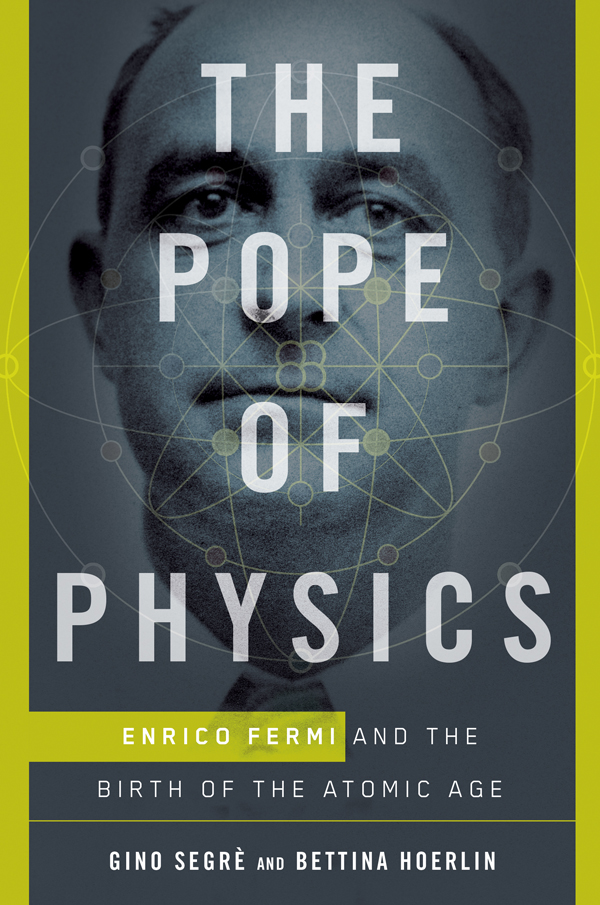
The Pope of Physics
Enrico Fermi and the Birth of the Atomic Age
فرمت کتاب
ebook
تاریخ انتشار
2016
نویسنده
Bettina Hoerlinناشر
Henry Holt and Co.شابک
9781627790062
کتاب های مرتبط
- اطلاعات
- نقد و بررسی
- دیدگاه کاربران
نقد و بررسی

Starred review from August 22, 2016
By placing stunning scientific advances into historical context, this engaging biography of Nobel Prize–winning Italian physicist Enrico Fermi (1901–1954) captures the life and times of one of the 20th century’s most creative and hard-working scientists. Husband-and-wife authors Segrè (Ordinary Geniuses), emeritus professor of physics at the University of Pennsylvania, and Hoerlin (Steps of Courage), a former Philadelphia health commissioner, quickly construct a captivating image of Fermi, addressing such elements as his love of hands-on work and his long friendship with fellow student and practical joker Franco Rasetti. Drawn to theoretical physics, Fermi helped advance quantum mechanics from mathematical abstraction to experiment, yielding a clearer picture of the atom and explaining beta decay—the Nobel-winning work that laid the foundations for nuclear physics and the modern device-dependent world. The authors describe how Fermi and Laura, his Jewish wife, sought refuge from European fascism and anti-Semitism in the U.S., where Fermi’s efforts produced the first nuclear chain reaction and fueled the Manhattan Project. Segrè and Hoerlin draw an engaging portrait of a man with boundless curiosity who delighted in his work; fans of pop science and history will thoroughly enjoy this entertaining and accessible biography of a scientist who deserves to be better understood.

The first English-language biography of Nobel Prize-winning physicist Enrico Fermi (1901-1954), a highly respected figure in both of the author's families.As Segre (Physics and Astronomy/Univ. of Pennsylvania; Ordinary Geniuses: Max Delbruck, George Gamow, and the Origins of Genomics and Big Bang Cosmology, 2011, etc.) and Hoerlin (Steps of Courage: My Parents' Journey from Nazi Germany to America, 2011) note, the title "Pope of Physics" was jokingly bestowed on Fermi at the start of his career by his colleagues because he was able to use "the simplest of means [to] estimate the magnitude of any physical phenomena." Segre's uncle, Emilio, was Fermi's first physics student in Rome, and the families maintained their friendship in the United States after they were forced to flee Mussolini's increasingly anti-Semitic regime (the Segre family and Fermi's wife, Laura, were Jewish). The authors use this biography of Fermi's life--beginning with his university days, when he immersed himself in the new field of quantum physics, and culminating in his own groundbreaking accomplishments--to engagingly chronicle the major developments in nuclear physics that were the focus of his life's work. Fermi played a key role in a revolution in physics that set the stage for the development of semiconductors, transistors, computers, MRIs, and more. In 1925, he extended the exclusion principle formulated by Wolfgang Pauli--that no two electrons in an atom could have identical quantum numbers--to the broader field of statistical mechanics. His most significant discoveries, made in the 1940s after his move to America, involved the possibility of using slow neutrons to induce fission reactions and create a chain reaction. Fermi's scientific work arguably played a key role in the rapid conclusion of World War II and the shaping of the subsequent Cold War. While he advocated for further efforts at international control of nuclear weapons, he did not join the anti-nuclear movement. A vivid retelling of events that still shape our lives today. COPYRIGHT(1) Kirkus Reviews, ALL RIGHTS RESERVED.

October 15, 2016
In this narrative biography of physicist Enrico Fermi (1901-54), creator of the first sustained nuclear reaction, husband-and-wife team Segre (physics, emeritus, Univ. of Pennsylvania; Faust in Copenhagen) and Hoerlin (former health commissioner; Steps in Courage: My Parents' Journey from Nazi Germany to America) discuss Fermi's milieu--the rise of fascism in Europe and the rapid advances in understanding particle physics and universal forces--with clarity. The historical passages at times resort to well-worn phrases such as sheer happenstance, but the authors succeed in "approaching Fermi in terms of person and place." They rely upon Laura Fermi's book Atoms in the Family as well as Emilio Segre's short biography Fermi, and include their own research, which further illuminates their subject as a brilliant scientist at a time of great upheaval, a humble family man who worked with, learned from and taught a who's who of 20th-century physicists. VERDICT Readers of history and physics will enjoy learning about this theoretical and experimental physicist, whose name lives on in the fermion particles, the element fermium, and the national accelerator laboratory near Chicago.--Sara R. Tompson, Jet Propulsion Laboratory Lib., Archives & Records Section, Pasadena, CA
Copyright 2016 Library Journal, LLC Used with permission.

Starred review from September 15, 2016
Suspected of Fascist sympathies, the Italian-born physicist Enrico Fermi looked like a bad security risk to the FBI in 1940. That judgment lends piquant irony to Segre and Hoerlin's illuminating biography of the immigrant genius who earned a prime place among the elite scientists who watched the planet's first mushroom cloud rise above New Mexico sands. Sparing readers the technical details, the authors recount how this genius brought cutting-edge science to his native land, uniting a team of talented countrymenthe Boys of Via Panispernaintent on assaulting the mysteries of the atom. After many of these mysteries yielded to Fermi's revolutionary slow-neutron probing, Fermi parlayed his Nobel Prize into a ticket out of Mussolini's dictatorship and into America, where he constructed the world's first atomic-fission pile on a University of Chicago squash court. As a man of pure scientific devotion, reputedly sharing with the Pontiff a magisterial infallibility, Fermi established himself (despite the FBI's misgivings) as a leading spirit of his new country's Manhattan Project. By exploring Fermi's friendships, his marriage and family life, and his postwar concerns about morality in an atomic age, the authors also give readers glimpses into some of Fermi's personal, nonscientific attributes. A balanced portrait, rich in revealing anecdotes.(Reprinted with permission of Booklist, copyright 2016, American Library Association.)

























دیدگاه کاربران